The Lawmatics Blog
Insights on legal marketing, automating the law practice, and legal tech in general
About the session
Behind every great client experience is a system quietly keeping things on track. The newest automation updates in Lawmatics build on that foundation, making it even easier to build and manage their automated workflows.
In this session, Devon Butler and Clare Struzzi walk step-by-step through what’s new. They cover trigger-based automations, appointment workflows, shared entry rules, and a simple way to organize everything in folders. Together, these improvements give firms even more control, flexibility, and time back in their day.
Webinar slide deck
Surely, by now, you’ve heard about TikTok, the video-based social media app that is all the rage. Initially, the platform gained popularity during the pandemic and lockdown as a way to entertain and connect people, but it persisted beyond 2020 and has exceeded one billion users. When it comes to TikTok, all you need is a phone with a camera and no editing required. TikTok has a unique algorithm that pushes content out to users based on their interests and geography, allowing law firms to reach a sizable audience without needing a large following which is very different from other social platforms. Many law firms still see TikTok as a platform for dancing teens, or at best, using it as a way to market their brand. But lawyers who are using TikTok will tell you it's a viable lead generation tool. Lawyers can effectively reach and engage with potential clients by leveraging the platform's unique algorithm, creating engaging content, and building a micro-community.
The underestimated power of TikTok: why law firms are missing out
Many law firms hesitate to dive into TikTok, especially if they have been experiencing diminishing returns on other social platforms, or they may view it as purely for entertainment. TikTok offers a creative way to reach potential clients and reinforce modern brand identity, allowing firms to drive interest and engage with audiences in unique and innovative ways that may not be possible through traditional marketing methods-–or even other social media channels. Of course, some camera-shy lawyers don’t want to be front and center in their marketing. Still, you can get creative with content that does not require individuals to be in front of the camera, such as showcasing office space, creating short animations, or using text overlays to convey information. The app offers various filters and effects that can add visual interest to videos, providing flexibility for content creation.Other barriers to using TikTok may include lacking content ideas or simply not having time to create content. Repurposing existing content in new and creative ways for TikTok can be a way to save your team some time. You can also start responding to comments and keep an open dialogue with engaged users.
Security concerns over TikTok
Before we move forward, it's worth noting that TikTok has faced scrutiny and concerns over its security and privacy practices, particularly its data handling and potential ties to the Chinese government. In 2023, there has been mounting pressure to ban the app in the United States, with TikTok CEO Shou Zi Chew appearing before Congress to defend their security measures. Some U.S. states have even moved to ban the app. The company has tried to address these concerns and improve its security measures, including hiring outside consultants and implementing stricter data protection policies. What does this mean for you? Well, if you are a TikTok user or just starting, it's essential for users to stay informed about any potential security issues and to take appropriate steps to protect your personal information when using the app. Additionally, it's probably wise to post from a device that does not contain client information on it. That said, I can think of a billion people who might not want their favorite social media app taken away.
Why TikTok is a goldmine for law firms
TikTok offers compelling reasons to consider it for its marketing strategy, providing a low barrier to entry with relatively low competition compared to other platforms (yes, still). With TikTok, you can still establish yourself to gain a competitive edge. With over a billion active users worldwide, TikTok offers an enormous reach, spanning various demographics and highly engaged users, making it an ideal platform for attorneys to connect with potential clients. Sure, you may not need leads in other geographies, but the algorithm accurately shows local content to users.People are turning to TikTok for information, and even Google execs have confirmed that their research shows that 40% of young people turn to TikTok or Instagram instead of Google Maps. If you want to be found, you need to be where people are looking. That’s where lead generation plays into TikTok. Many law firms use TikTok to give general advice, stay top-of-mind, and nurture potential leads. TikTok's short, snappy video format allows attorneys to uniquely showcase their creativity and personality uniquely, creating engaging videos that educate their audience on legal topics, share client success stories, or give behind-the-scenes glimpses into their law firm culture.
TikTok's algorithm: size doesn't matter on this social platform
TikTok's algorithm has flipped the traditional social media model of first needing a large following to see a return on marketing investment. Instead, the app's algorithm considers your video engagement, not just your follower count, meaning that even new accounts can start getting engagements fast. Because of this, Jessica Aires, founder of By Aries- a legal marketing agency, says lawyers are getting quality and local leads on TikTok in a way that has not been seen since the early days of social media platforms like Facebook and Twitter. The platform's micro-communities are formed by shared interests, geography, or niches and can be highly engaged and interactive. These micro-communities allow lawyers to connect with potential clients with a genuine interest or need in their area of expertise and vice versa. They create a more targeted and engaged audience, as people who follow your TikTok account will likely be genuinely interested in the content you share.
Navigating TikTok as a new user
On TikTok, you can create short-form videos set to music, with options to add effects, text, and stickers. One of the key features of TikTok is its personalized feed, known as the "For You Page” (FYP). The FYP relies on the algorithm to curate content based on your interests and preferences, which is how you can discover new content that aligns with your interests. You can also browse through videos from accounts you follow, like and comment on videos, and engage with trending sounds or hashtags. Initially limited to 15 to 60 seconds, TikTok has expanded its video length options, allowing users to create videos of up to 3 or even 10 minutes. This gives users more flexibility to create more detailed content on the platform, although the standard length is still about a minute.
Definitions of TikTok features
Below are the main terms and features you need to know if you will use the platform. Duet: A duet is a collaborative feature on TikTok that allows two users to create a video together by filming themselves separately but having their clips appear side-by-side in the same video. Duets enable users to create content responding, or reacting, to each other's videos, creating a collaborative and interactive experience.Stitch: Stitching a video is when you start the video with the original content and “stitch” your response to the video. Instead of two videos side by side, you’ll have one video that shows up.Sounds: Sounds are audio clips that can be added to TikTok videos, such as music or sound effects. Users can choose from a wide range of sounds already available on TikTok or upload their own audio. Using trending sounds is a great way to get in front of other users. FYP (For You Page): It’s an algorithmically generated feed specifically tailored to each user, showcasing content likely to be interesting and relevant to them based on their previous interactions on the platform. The FYP is a key aspect of the TikTok experience, providing users with a curated feed of content tailored to their individual preferences.Filters & effects: Effects are creative tools and visual enhancements that users can add to their videos on TikTok. These can include filters, special effects, text overlays, stickers, and other visual elements that can enhance a video's overall aesthetics and appeal, allowing users to add their creative touch and make their videos more engaging and visually appealing.Livestreaming: TikTok lets users livestream content in real time, creating an interactive and engaging experience with their followers. Users can go live and interact with their audience through comments, likes, and virtual gifts, allowing for real-time engagement, Q&A sessions, and behind-the-scenes glimpses into the creator's life or content creation process.
Types of videos you'll find on TikTok
You'll be bombarded with unrelated videos when you first start watching your FYP. But as you engage with each video, the algorithm will determine your preferences. Here are some of the types of videos you’ll see on TikTok:
- Lip-sync videos involve users miming popular songs or audio clips, syncing their movements and expressions with the music to create engaging and entertaining content.
- POV (point of view) videos can be lip-syncing videos or skits with the text "POV" describing who is talking, often playing on a trending sound. These videos provide a unique perspective by simulating a first-person point of view, allowing users to portray different characters or situations creatively.
- Dance videos are a popular genre on TikTok, with users performing choreographed moves in time with the music. These videos often feature impressive dance routines, creative interpretations of popular songs, and participation in viral dance challenges.
- Vlogs are video blogs where users share clips from their day, thoughts, opinions, and experiences with viewers, typically about everyday life. Vlogs can cover a wide range of topics, from travel adventures and personal stories to behind-the-scenes glimpses into the creator's life.
- Educational videos on TikTok provide viewers with information about a specific topic or subject matter. Creators often talk directly to the camera, delivering informative content concisely and engagingly, making complex concepts accessible and entertaining.
- Reaction videos involve creators stitching or dueting another video in response to it. Creators react to content created by others, adding their commentary, opinions, or humorous reactions, creating a dialog or interaction with the original video.
- Comedy and skits are where users create skits, parodies, and comedic videos. These videos often feature scripted or improvised comedic situations, humorous impersonations, and comedic timing, showcasing users' comedic talents.
- DIY and life hacks when users share practical tips, tricks, and hacks. Users create videos demonstrating DIY projects, life hacks, cooking recipes, and beauty tutorials, providing viewers with useful and practical information in a visually engaging format.
And we’d be remiss if we didn’t include the all-important pet videos. TikTok has many cute and funny pet videos showcasing adorable animals and their antics. These videos capture heartwarming, funny, or viral moments involving pets of all kinds, from dogs and cats to exotic animals, providing viewers with joy and entertainment.
5 tips for setting up your legal TikTok for success
When you are first starting on TikTok, there are several foundational things you should do to establish a strong presence and maximize your chances of success:
1Familiarize yourself with TikTok culture
TikTok has unique cultures and trends. Users are particularly aware of when businesses are non-users or aren’t engaged with TikTok. Spend time exploring TikTok, engaging with popular content, and understanding the content that performs well on the platform. 2 hours on TikTok spent browsing will help you create content that resonates with the TikTok community.
2Optimize your profile
Your TikTok profile serves as your business's main hub on the platform. Use a clear profile picture, write a concise bio, and include a link to your website. You only get one link in your bio page, and you can also use a bio link that serves as a landing page to link out to multiple sites. You can use the bio link to your website, other social media platforms, specific blog posts, or fundraisers.
Legal disclaimers
Better to be safe than sorry. Make sure to have a short disclaimer that says all your content does not create attorney-client relationships. Always emphasize the importance of seeking professional legal advice for individual cases, and avoid providing specific legal advice or creating false expectations. Use common sense around your social media marketing, and check your local Rules of Professional Conduct. Additionally, disclose any sponsored content or partnerships clearly in your videos.
3Create engaging content for your areas of law
TikTok provides a unique platform for creating content and engaging potential clients. By creating informative content, firms of all sizes can connect with potential new clients. On TikTok, production quality doesn't need to be high to be engaging; the content must primarily offer value to viewers. You can start today on TikTok by taking a quick video of you sitting at your desk or going on a walk and just talking to the camera about any topic. Remember to use clear (aka. non-legalese) language. You can use visual aids to make your content more entertaining, but videos featuring a person talking directly to the camera are viewed as the app's most authentic type of video. With all of your content, leverage hashtags and trending sounds (which you can have on very quietly or even muted) to get your videos to appear prominently on other FYPs.
A quick & easy content strategy to start with
Let’s work backward to create a content strategy. Start by considering what types of cases/matters you want to start getting. From there, start creating videos around the concerns that those clients have. While there are more strategic ways to do content marketing, like creating a content calendar with 28-30 ideas to plan your ideas, you can also start by winging it. Videos could include legal tips, explanations of complex legal concepts, behind-the-scenes looks at your office and staff, and engaging storytelling about old cases (without specific client details, of course). To streamline content creation on TikTok, attorneys can film content in batches- which means you sit down and record, let’s say, 10 videos at a time. You can film a batch of videos weekly to save time and ensure consistent weekly posting. Check out these 9 Attorney TikTok Accounts You Need To Follow For Marketing Inspiration.
4Engage with other users
Once you get going, you’ll start to get some comments from other users. You can then film responses to those comments or use the comments to make videos about specific topics. You can also respond to comments with text. This engagement will serve as a way to generate more ideas and help you start creating your micro-community.While on TikTok, try to engage with other users' content by liking and commenting on their videos to build relationships, increase visibility, and grow your TikTok following.
5Set up marketing attribution to track leads
If a user from TikTok reaches out to your law firm, but there is no tracking or attribution back to TikTok–did it really even happen? Well, sure…but it’s better to know where your leads are coming from.Monitoring and analyzing your TikTok performance is crucial to understanding what works and what doesn't. Use TikTok's analytics tools to track metrics such as views, likes, shares, and comments and analyze the performance of your content. Metrics like these will inform content strategy, identify trends, and make data-driven decisions to improve your TikTok presence.You can track leads from TikTok by using custom tracking links, unique landing pages, or specific call-to-action prompts in your videos. You’ll want to differentiate leads from TikTok versus any other social media platform so you can understand the effectiveness of TikTok.
Ready to get started with TikTok for your law firm?
By following these foundational steps, law firms can establish a strong presence on TikTok and leverage the platform's potential for brand awareness, engagement, and driving quality local leads to their firm. It's important to be consistent and authentic in your content, engage with the TikTok community, and analyze your performance to optimize your TikTok strategy.TikTok is an ideal platform for tapping into the ever-growing online space and introduces more opportunities for expanding your reach. TikTok provides an easy and fun way to generate leads for your law firm without spending much money or needing a large following. All you need is a camera and a basic understanding of how to use features on the platform to reach a wider audience. Lawmatics can help your growing law firm track and manage potential new clients. Get a demo today to see how we can help you attribute leads to specific marketing channels, like TikTok.
Search engine optimization (SEO) is a process intended to drive more leads to a website by boosting the site’s position in search engine pages like Google or Safari. Digital marketing for law firms should include SEO to help ensure that their firm appears near the top of search engine results (preferably on the first page). In turn, more potential clients will visit their website. Law firm marketing automation can help put this process on autopilot.
Why do law firms need SEO?
According to Clio, 57 percent of legal clients find a lawyer through online search results. In other words, if a law firm appears on the first page of search engine results and a visitor clicks on the link within the results, if the site gives them basic information they are looking for, they’re more likely to reach out to learn more about the firm’s services. So although there are no guarantees that your law firm will reach the top of organic search results, SEO can help improve your chances – if it is done correctly.
How to do SEO for lawyers
Law firm SEO performance depends on several factors:
- Content. The words used, along with the images on the pages of a website. To improve user experience and improve SEO, ensure that your site features high-quality, informative content.
- Backlinks. The credibility a firm has online as compared with other firms. The number of external websites and pages directing traffic to a firm’s website determines its authority.
- User experience. When Google ranks websites, it considers page speed, title tags, and site structure, all considerations lawyers should make when evaluating their website.
SEO keywords for lawyers
When Google evaluates websites, it sends an automated bot to read the content to understand what each page is about. To help rank your website, your content must be keyword optimized, meaning your content contains the best keywords to target qualified traffic.Many people will search by the most common keyword, but others looking for a lawyer will ask questions in natural language or enter variations of the same keyword. The goal is to create as much content as possible that addresses search inquiries related to your primary keyword. Primary keywords describe your firm’s services and areas of practice, e.g., “personal injury lawyer,” or “immigration attorney.”
Local SEO for lawyers
Local SEO focuses on what people type into search engines like Google when looking for answers to their questions. Local people use these searches to look for local products, services, or information. For example, local searches for a lawyer can range from “lawyers Chicago” to divorce attorneys near me” and unlimited alternatives in between. Local searchers can also trigger specific local results, such as local maps, which is why local SEO is important for law firms and lawyers that serve a particular geographical area.
Google Ads for lawyers
Google ads for lawyers, commonly known as “Pay Per Click or PPC,” utilize advertising paid for only when someone clicks on it to view a website. With PPC advertising, the search engine wins because they get paid a fee for that click, the client wins because they just discovered a potential lawyer to reach out to, and the law firm wins because they just found a targeted potential customer – for a price. Although the cost of PPC for lawyers depends on the extent to which the firm needs new clients, how competitive the target market is, and what kind of budget the firm has to work with, a typical PPC budget for a law firm can exceed $1,000 per month.
What is an algorithm in SEO?
Algorithms are used in SEO to provide the most helpful answers to a potential client’s query (what users type into a search engine). While search engines often keep the details of their algorithms to themselves, information can often be determined by how the results have changed. Algorithms used in SEO are constantly evolving to become more sophisticated, and to rank higher in search results, attorneys must build content that is more than just topically relevant. Research indicates that longer, in-depth content that is more authoritative and comprehensive than other content in the same niche tends to rank higher overall in Google search results.
How to promote a law firm?
Lawmatics law firm marketing automation software allows law firms to see where each lead stands at a glance, ensuring that your SEO efforts do not go to waste. To learn more about how the Lawmatics platform will boost your firm’s SEO strategy, request a free demo today.
A strategic law firm marketing plan will provide a blueprint for the firm’s future growth. It will identify which areas the firm wants to grow and address how to streamline the process, including law firm marketing automation. After all, if you embark on a journey without a map (or GPS), you may not get anywhere, much less to your desired destination. Digital marketing for law firms can help define the direction you need to take. But before we explain what the 6 components of a marketing plan are, let’s get back to the basics – why is law firm marketing so important?
Why do law firms need marketing?
Marketing your law firm is essential to the success of your practice and an efficient way to consistently find and retain clients. A law firm marketing plan should include a combination of digital marketing, SEO, blogging, social media messaging, and digital ads. In addition, to save time, increase efficiency, and help ensure success, a firm should leverage law firm marketing technology to automate various tasks.
What are the 6 elements of a marketing plan?
Law firms interested in growth need a personalized legal marketing strategy that includes marketing strategies for individual lawyers and law firms, and typically includes websites, branding, social media, blogging, emailing, and more. You can use these elements to create a marketing plan template unique to your firm:
1 A detailed description of your goals
Your marketing goals need to align with your firm’s quantifiable business goals. The ultimate goal of law firm marketing strategy is to acquire and maintain clients. Achieving this goal requires building brand awareness with your target market, generating leads through marketing efforts, converting leads into clients, and promoting repeat business and referrals. Ensure that your goals are measurable to track their progress as you reach milestones.
2 A definition of your target market
Creating targeted messages is much easier once you know who you are marketing to. Your target audience will typically include past clients, current clients, industry contacts, other attorneys and law firms, professional groups, referral sources, and the media. Your messages must express what makes your law firm (or you as a lawyer) unique, so develop messages that will communicate the value you bring to your clients to differentiate you from the competition.
3 A realistic marketing budget
A carefully planned marketing budget is critical to any law firm’s marketing efforts. To decide on a number, you’ll need to determine your goals and how much revenue you will need to reach them. Then, to figure out your overall marketing budget, examine how many cases per year you will have to manage to meet that goal, factoring in potential costs such as the marketing technology you will need to produce social media scheduling and email marketing campaigns.
4 Knowledge of current trends
When developing a marketing plan, it is essential that you familiarize yourself with the current marketing trends present in the legal industry. One of these trends is video marketing, which is very effective for personal injury advertising that uses emotional marketing as a strategy to obtain clients. Another is to create a legal podcast – marketing experts predict that there will be 504.9 million people listening to podcasts by the end of 2024. Legal podcasts typically discuss various topics, including current legal cases, significant legal developments, and explanations of legal concepts and terms.
5 A focused brand identity
A law firm’s brand is how potential, current, and former clients, referral sources, and others perceive the company. Law firm branding incorporates your logo, website, and marketing materials. It should include both written words and a visual presentation of who you are and how you want people to feel when interacting with you and your law firm.
6 A plan of action
Marketing activities include content development, advertising, social media, email marketing, and more. Although you might decide to roll out different tactics on a scheduled basis or launch everything all at once, either way, the successful execution of your plan depends on the utilization of law firm marketing software.
Measure the effectiveness of your law firm's marketing with Lawmatics
Lawmatics law firm marketing automation technology enables firms to automate the leg work of their marketing efforts to drive business growth while staying focused on clients. To learn more about how Lawmatics can help you seize every new client opportunity with targeted messaging and impeccable timing, request a demo today.
Spring has sprung at the Lawmatics office and we’ve got another round of new features in bloom! Last month we announced our new Create From Within user experience; we are thrilled to share more developments to this project as well as other new additions and improvements all throughout the platform.
New display options for true/false Custom Fields
Custom Fields have always been a staple of the Lawmatics CRM, so why not introduce further customization options? With this new feature you can now select from three different display options for your true/false fields: toggle (previously the only option), a checkbox, or a picklist displaying options of “Yes” and “No”. Select the option that is best suited for each Custom Field to give your clients the best possible experience when filling out your intake forms.
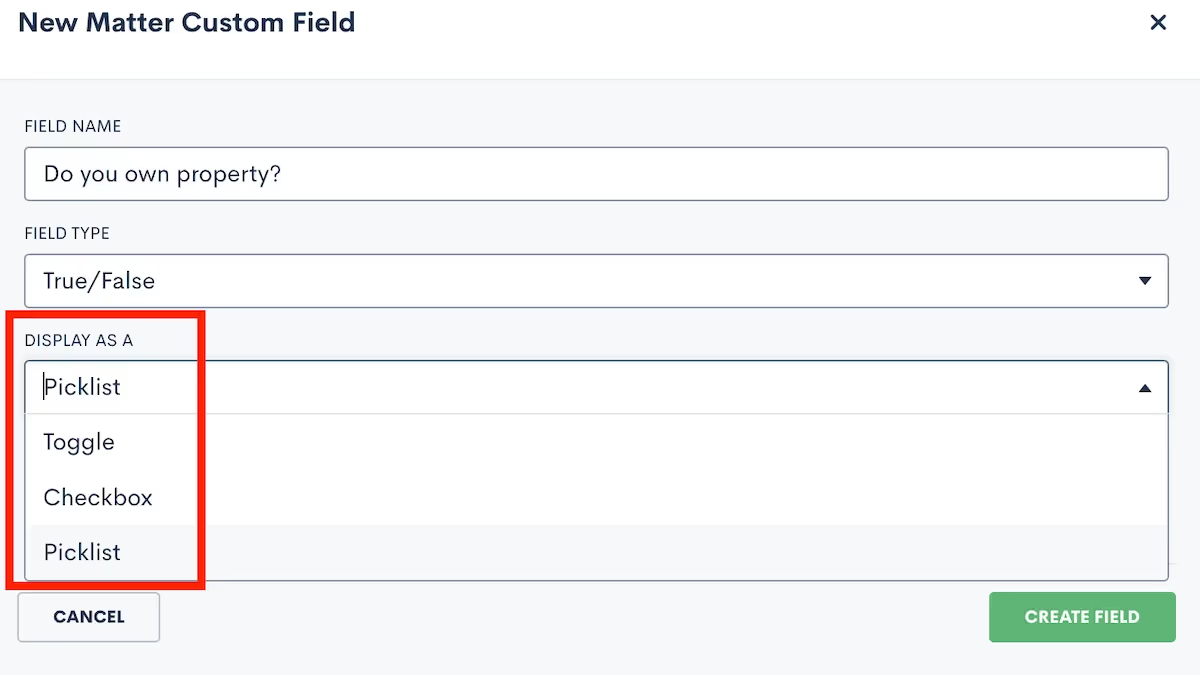
We’ve also introduced the option for true/false fields to be designated as either "Required" or "Required To Be True".This gives you the flexibility to enforce the selection of a "true" or “false” answer - particularly when a "false" response would result in disqualifying a potential lead.
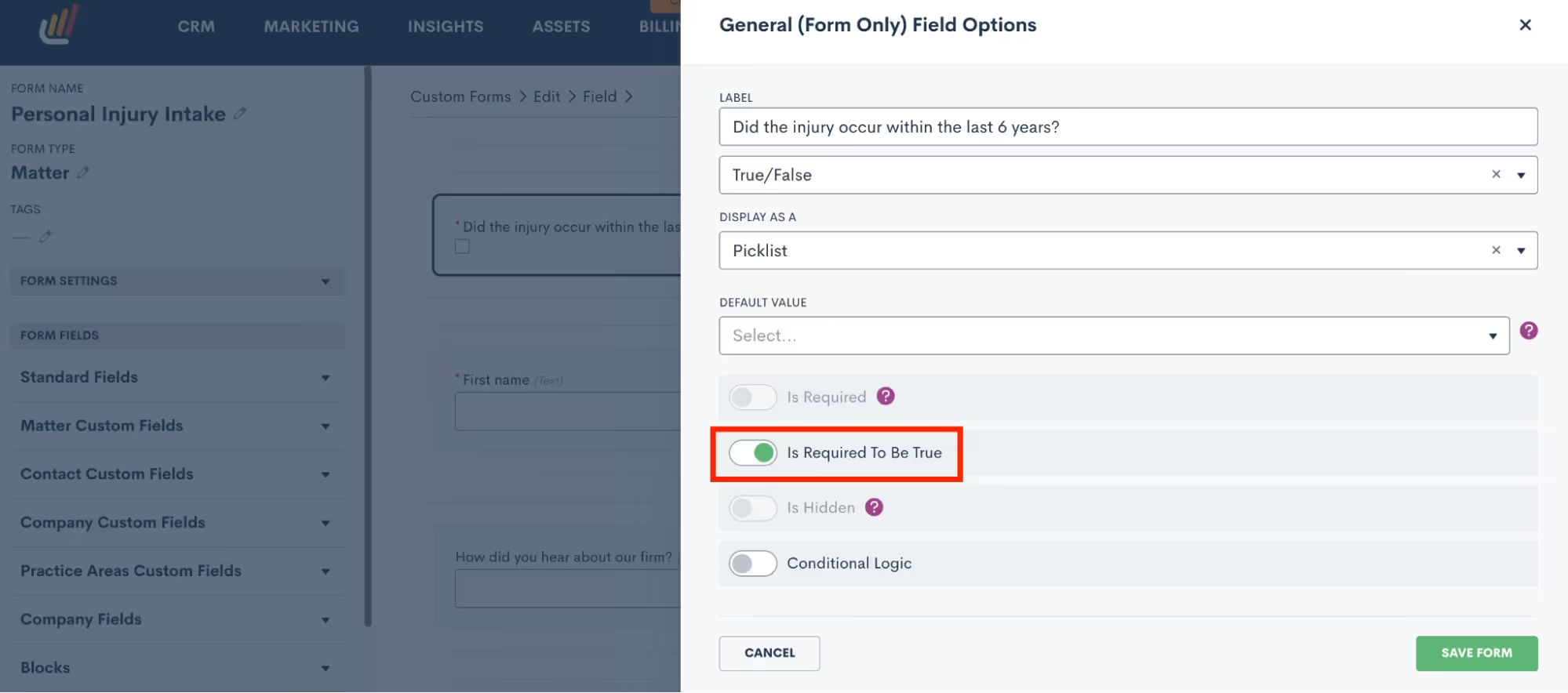
Click here to learn more about custom fields.
Select All option on Matter Page
You already love the ability to bulk update or delete matters in bulk, but we’ve now enhanced this capability by allowing you to select ALL matters without needing to go from page to page. Simply click the checkbox at the top left, highlighted below, then click the Select All option to check all of your total matters. Any updates made will now apply to all matters selected. This new improvement makes it much easier for you to bulk edit a large selection of matters all at once.
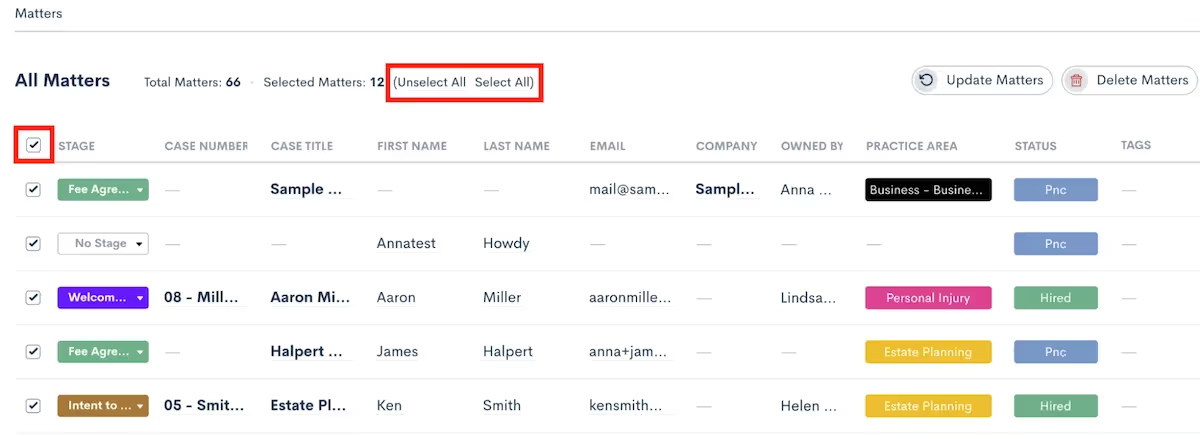
New Create From Within updates
Build a New Custom Form Within Automations and Matter Profile
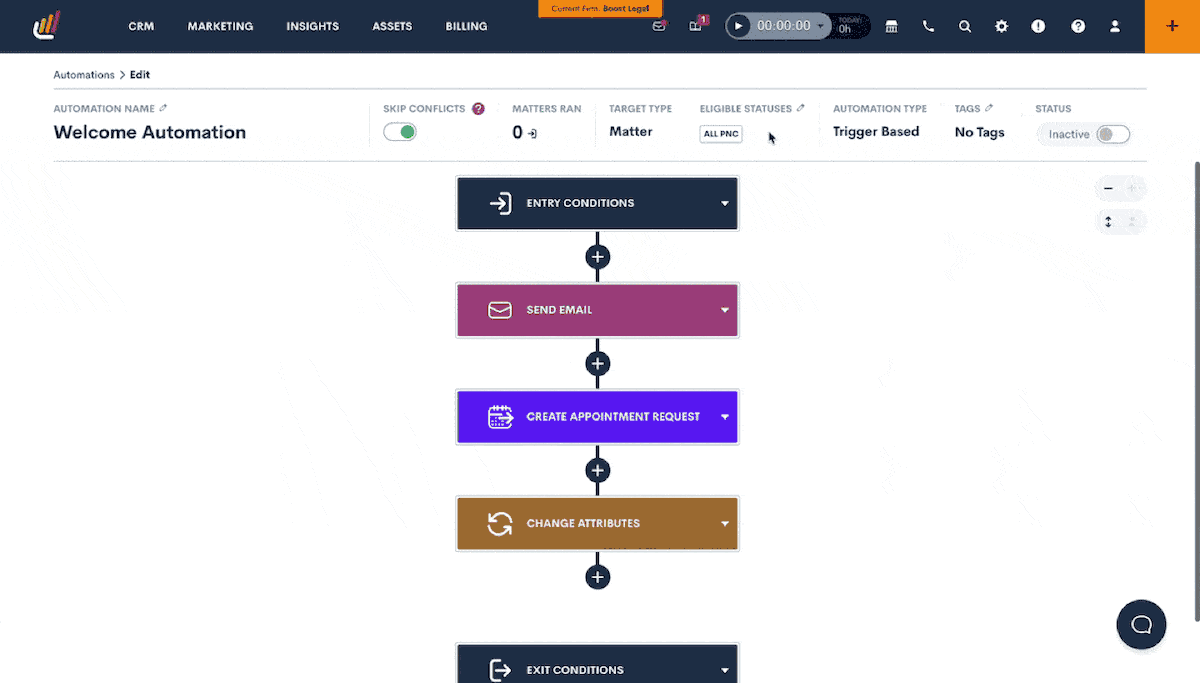
Create New Pipeline and/or Stage When Adding New Matter
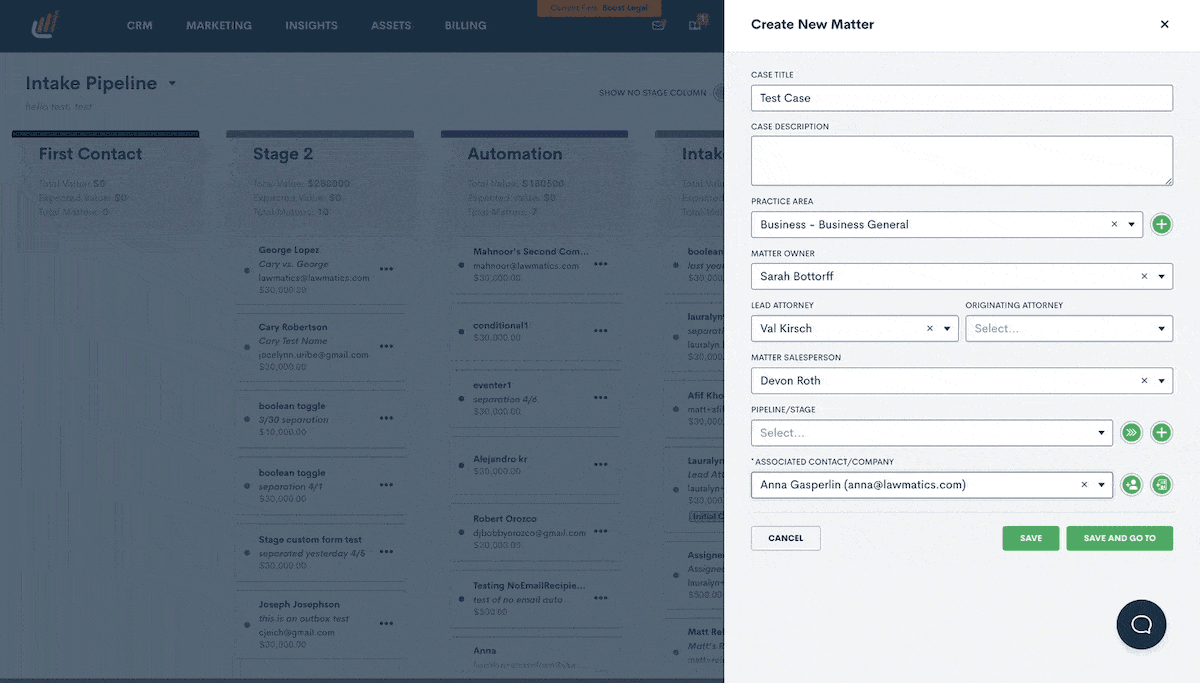
Add New Practice Areas from Practice Area Field Selection
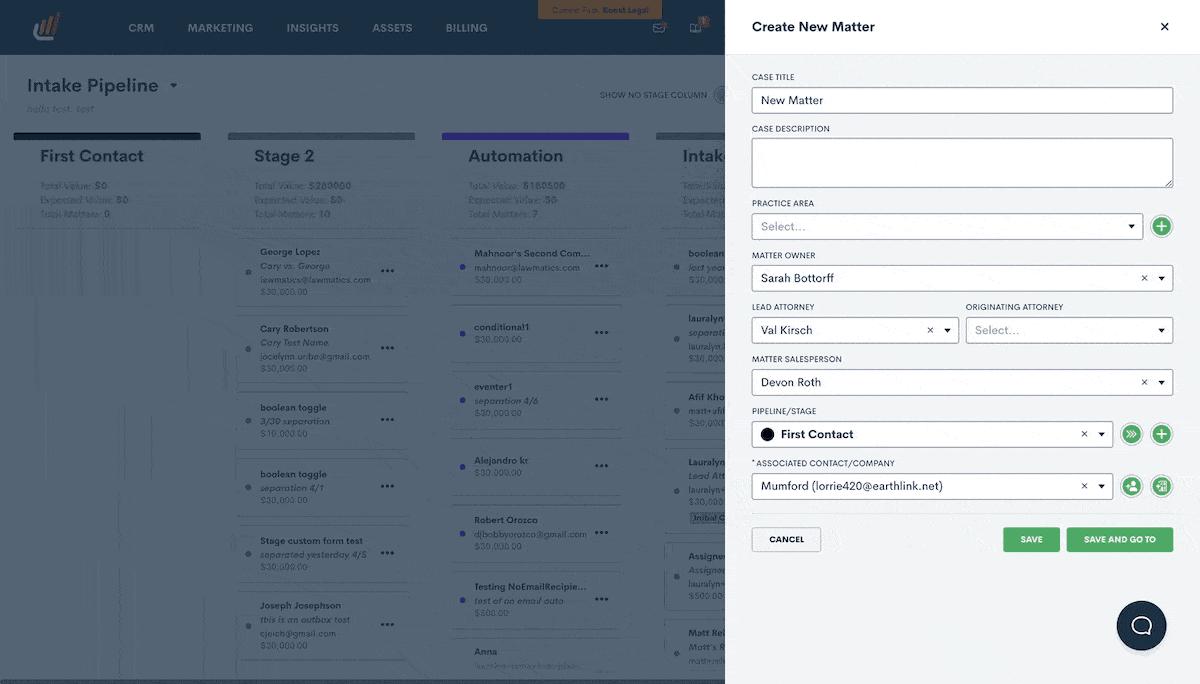
New Relationship Types Directly From Matter Profile
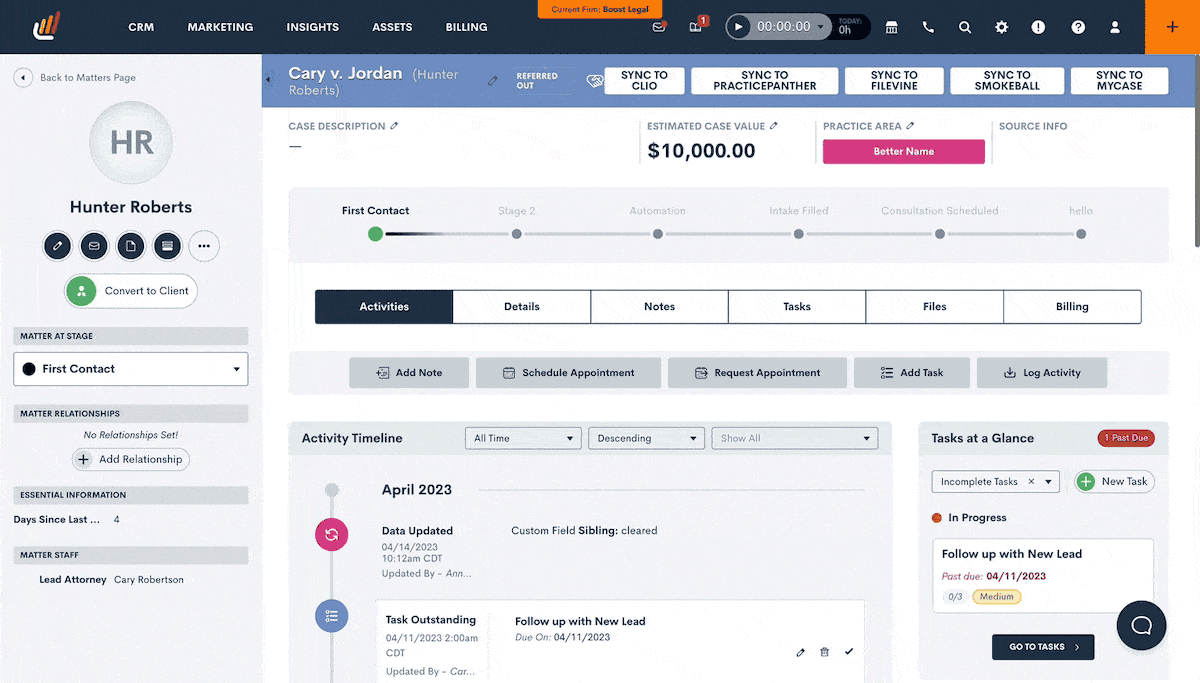
Also In This Release
Relative Time Filtering Option for Date Fields
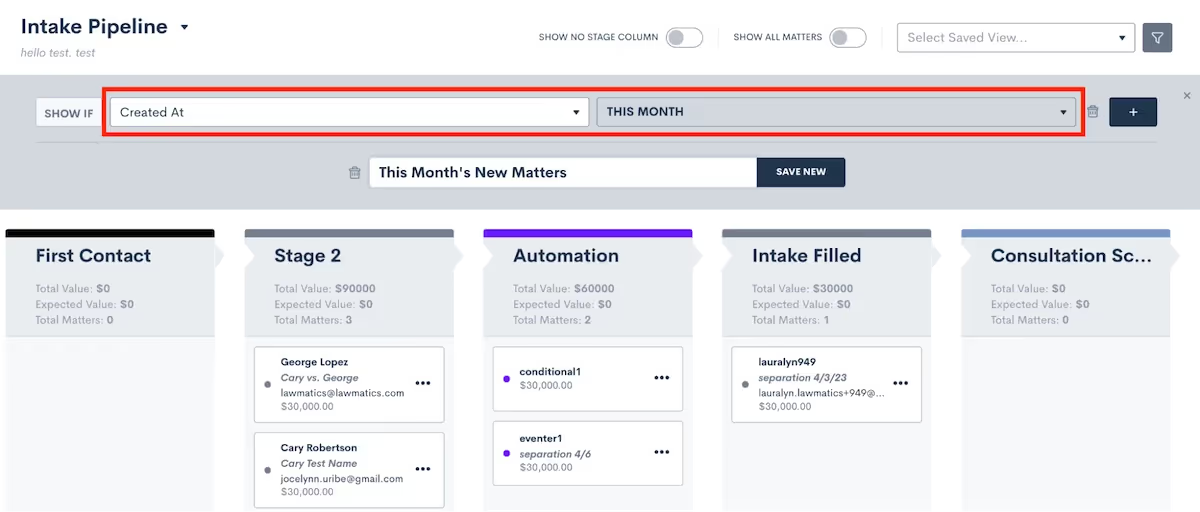
Particularly useful for honing in on particular matters within specific time windows, you can now select from relative date options such as “this month” or “last week” any time you are using a Date Field as a filter in the platform. This is also available in Reports and Audiences.
New Layout in Custom Form and Custom Document Builders

In alignment with our other user experience improvements, we have also reorganized both the Custom Form and Custom Document editor for improved usability when editing selection options such as Internal Use and Form/Doc Recipient Type.– We hope these new features are just what you need to dust off winter and hop into the new season! As always, feel free to share your thoughts or questions with us by emailing support@lawmatics.com.
Successful marketing is critical to attract new leads and remain profitable, but many law firms don’t have the time or the resources to create a dedicated marketing campaign. After all, most lawyers already have too much on their plate to focus on obtaining new clients – they’re usually knee-deep in managing the clients they already have! In addition, it often takes several consecutive follow-ups before a new lead is ready to hire an attorney. Law Firm Marketing Automation can help automate the marketing process to ensure that leads are nurtured and clients are maintained – with minimal administrative effort from lawyers and staff. In this guide, we'll explore the answers to questions like:
- How does marketing automation work?
- What is the main purpose of marketing automation?
- What are marketing automation benefits?
What is marketing automation and how does it work?
Marketing automation involves using software and other technologies to automate manual tasks and enhance the success of online marketing, including email, social media, websites, and content published by the firm. The tedious administrative work required to operate a law firm – including marketing the practice - can consume a considerable part of a lawyer’s day. However, the marketing must get done somehow as it is critical for attracting new clients and keeping up with the competition. Marketing automation software automates time-consuming tasks that don’t require an attorney’s expertise. For example, it might be as easy as developing an email marketing template that sends messages out automatically, allowing prospects to receive timely and personalized marketing information. Automation also enables lawyers to measure the success of their marketing efforts, thanks to visual analytics features built into the software.
Marketing automation software: a summary
Marketing automation is computer software that completes marketing tasks that do not require human interaction, including everyday marketing automation workflows like email marketing, lead prioritization, and tailored advertising. Marketing automation is especially critical for lawyers with multiple cases, numerous client meetings, and busy schedules. Although it can be incredibly challenging for a lawyer to find time to generate leads, with marketing automation, they can efficiently market their law firms while focusing on client cases. So, what is the main purpose of marketing automation? Simply put, to use available tools to provide the best possible client experience and, in turn, produce more revenue.
Benefits of automation in the workplace
“
“Too often, lawyers are trying to pilot the plane, and hand out the pretzels.”
While delegation is a proven method for driving efficiency, law firms don’t always need to delegate work from managing attorneys to associate attorneys or staff; automating tedious tasks and processes is much more effective. For example, consider the numerous steps involved in new client intake: scheduling, emails, contact forms, chat or text communications, and contracting. All those steps in the intake process can be automated with online scheduling tools, messaging applications, e-signature capabilities, and e-payment systems. Because each step in that process automatically triggers the next, modern software can automate workflow without human intervention, so law firms can effectively manage time and make more money. When used appropriately, there are many marketing automation benefits for law firms, including:
- Streamline communication - Workflow automation significantly improves communication between legal team members. Since employees frequently cite stress due to poor communication as a reason for leaving an employer, automation software can help reduce firm turnover. Workflow automation also improves communication by eliminating the need for team members to remind each other when something needs to be done – those reminders will be sent automatically.
- Increase accountability - Firms that automate their workflow can assign responsibility to a team member for every part of the process, significantly decreasing the chance of something slipping through the cracks. When each step of the process is assigned to a team member, it not only helps ensure all of the work gets done but can also expose inefficiencies in your approach.
- Save money - Workplace automation saves a law firm money by allowing it to avoid costly errors, streamline processes, and help team members perform more efficiently. It can also provide the ability to reduce labor costs since repetitive tasks will be completed automatically.
- Engage employees - Because workflow automation help clarify employee roles and the tasks they are responsible for, allowing them to manage their work more efficiently and take accountability for whatever goes wrong. With automation, managers do not need to oversee every step of the process or micromanage employees.
- Improve efficiency - Workflow automation software makes it simple to assign roles, parse out tasks, and grant responsibilities to the appropriate team members, accelerating processes that typically require manager involvement.
- Boost productivity - Workflow automation allows employees to devote their time to higher-value responsibilities. In client-facing industries like law, this can enable attorneys to serve more clients in a shorter period of time, boosting profit margins.
- Produce higher quality work - When lawyers and key staff members have more time for the critical work they care about and were hired for because software handles the mundane and lower-value tasks, a higher quality output will generally result.
Workflow automation technology helps law firms improve communication, control costs, enhance efficiency, and empower team members via accountability and the time to focus on what matters.
What is database marketing?
Database marketing (also known as customer relationship management or CRM) is a form of direct marketing that systematically collects, consolidates, and processes consumer data. Data of both customers and potential customers are collected and maintained in a company's database.Database marketing aims to target clients based on several factors, including suitable markets and proper channels, to maximize the chance they will respond to the contact and eventually become your client. As a result, database marketing is a highly effective way to find new clients and get more work from previous clients. Building your list (database) is an integral part of this process since the quality and relevance of your list will be critical to the success of your marketing efforts.One type of database marketing is a personalized email drip campaign, an automated cycle of emails sent on a specific schedule. For example, if a client signs up for a newsletter or sets up a meeting, it will trigger a series of automatic marketing emails sent out over a designated period. The intent of a drip campaign is to keep clients engaged without having to manually engineer the process – the software does that. Meanwhile, legal teams can concentrate on what they do best—practice law.Unlike traditional automated emails, drip marketing provides a more advanced and tailored message to the right person at the right time. From a welcome email to a promotional message offering more information about a firm a few days later, drip email marketing nurtures, engages, and leads prospects through the client journey using personalized content rather than generic messaging. Because it is Intuitive and time-triggered, email drip marketing makes a law firm stand out.
How customer databases help achieve marketing success
Customer databases help law firms increase insight into client behavior and can determine what’s next for their target market overall. To succeed in database marketing, they should:
- Identify client groups. Separating clients into groups (from high-value clients to potential leads) is an excellent way to keep various groups organized within customer databases.
- Create detailed customer segments. Audience segmentation based on demographics, behaviors, or personal interests helps deliver tailored messaging to custom groups of prospects and clients.
- Design highly personalized messages. Creating personal messages for both current and prospective customers can provide a favorable impression of a firm, increase brand loyalty, and increase engagement.
- Determine when and how to engage customers. With a customer database, marketers can determine what types of content are the best fit for specific platforms to increase awareness and enhance customer engagement.
- Improve marketing efficiency. Your time and money are precious. An updated customer database will help you avoid wasting time and money on marketing campaigns directly to those who are unlikely to respond.
- Enhance customer service. Customer databases provide support staff with a broad perspective on customer interactions with your brand, allowing them to improve your firm’s customer service.
There are many ways to collect data. However, some tools designed to track information on marketing data can lead to fragmented systems within your firm. In the end, having an all-in-one, easy-to-use solution is generally best.
What is sales automation?
Sales automation, often a feature of CRM software, is functionality that automates the repetitive tasks critical to providing simple and profitable customer journeys. A range of digital tools exist to automate various parts of the sales process. From generating leads to automating follow-up emails, sales automation technology helps teams handle sales activities more proficiently so that they can allocate more time to revenue-generating tasks.Every law firm needs to boost the number of leads in their sales pipeline because additional prospects translate into more clients and higher profits. However, firms need more than spreadsheets and Gmail to handle the amount of work that goes into nurturing leads. Automation sales tools allow law firms to manage a larger volume of leads in their sales funnel and create a standardized sales workflow that can be refined over time.To grow your law firm, you must find a way to handle more leads without sacrificing responsiveness. Automated sales tools will allow you to contact more potential clients and guide them through your sales pipeline while providing personalized messages supporting your firm’s brand.
What are 6 benefits of automation?
Here are a few practical benefits of automation that can help your law firm scale productivity without increasing overhead:
1 Get more done in less time
Greater productivity is one of the chief benefits of automation. For example, legal teams spend far less time preparing and organizing documents when they can click a few buttons and have data auto-populate in their preferred template. In addition, document automation allows more time for billable tasks that increase profitability, which is especially critical if your law firm is pressured to get more work done with fewer resources.
2 Gain a competitive advantage
Document automation can be a powerful marketing tool for law firms. Clients want to partner with law firms that use innovative technology to do work in the most efficient way possible. In addition, client confidence (and referrals) will surge when they observe how your firm delivers quality service on time.
3 Create and process documents cost effectively
One of the prime reasons why law firms choose automation is to cut costs. With document automation software, you might not have to hire another paralegal to manage stacks of documents. Automation also allows law firms to save money on office supplies, giving firms the ability to invest in other more critical areas.
4 Improve document quality and accuracy
Copying and pasting data from one spreadsheet to another is extremely prone to human error, frequently resulting in typos and mistakes that even the most careful proofreaders might miss, negatively impacting compliance and risk. Documents populated with essential information via automation instead of manual processes greatly reduce costly errors.
5 Streamline responsiveness to clients
Another main benefit of automation is the ability to give clients the answers they need as quickly as possible. In addition, When preparing documents for clients, they can be delivered in a fraction of the time it would have taken with manual methods. A faster, more efficient response translates into happier clients and accelerated growth.
6 Standardize document format and content
With document templates and custom fields, legal teams can easily standardize documents to improve consistency, keep everyone on the same page, and ensure everyone works from the same document library. Automation allows legal professionals to devote time to tasks that demand their expertise, such as developing strategies, providing advice, and completing billable tasks. By embracing automation, teams can get more work done in far less time.
Attract more prospects and win more clients with marketing automation
Automate the leg work of your marketing efforts to drive growth in your business while staying focused on your clients. Lawmatics law firm marketing automation helps you seize every new client opportunity with targeted messaging and impeccable timing. To find out how Lawmatics can help you set up powerful, automated workflows to delight your existing clients and win repeat business, request a demo today.
According to the American Bar Association (ABA), over 1.3 million attorneys were actively practicing in the U.S. as of January 1, 2022. In addition, more than 45,262 solo practitioners are currently employed in the United States. However, whether a lawyer works for a large firm or maintains a solo practice, they all have at least one thing in common: taxes.Law firms and attorneys are confronted with many unique tax issues and must be keenly aware of the tax rules that apply to them and their practices. In addition, the tax practitioners they work with must understand the specific accounting and tax concerns that lawyers and law firms have.
“
“Today, it takes more brains and effort to make out the income tax form than it does to make the income.”
— Alfred E. Neuman
The importance of organization
There are many nuances to practicing law, but when it comes to running a law practice, the challenges are similar. For example, all firms and lawyers must track business expenses to manage their taxes properly. However, if they understand how and where to find the best tax deductions, they can keep more money in their pocket by deducting things like continuing education and travel expenses. This eBook is intended to help lawyers and law firms:
- Understand their tax filing obligations
- Become familiar with the applicable IRS tax forms
- Effectively organize your firm’s financial records
- Maximize deductions and tax credits
- Learn to work with a tax professional
- Develop Tax Planning Strategies
- Remain Compliant with Tax Laws and Regulations
At tax time, there are consequences for how employees are hired, how lawyers and partners are paid, how equipment is purchased, how cash is saved, and more. That is why law firms and lawyers must understand their finances to survive tax season.
Understanding the tax filing requirements for law firms
Lawyers have unique tax responsibilities depending on whether you’re a solo attorney or have a small firm. So, the first step is to know when you must report and pay based on your jurisdiction and entity type:
- Sole proprietorships. An unincorporated business owned by one person.
- Partnerships. Two or more people contribute money, property, labor, and skills and share in the profits and losses of a business.
- Corporations. Entities formed by prospective shareholders to exchange money, property, or both for the corporation's capital stock.
- S Corporations. Corporations designed to pass income, losses, deductions, and credits to shareholders for tax purposes.
- Limited Liability Companies (LLC). A business structure allowed by state statute under various regulations. Members may include individuals, corporations, other LLCs, and foreign entities.
Whether an attorney owns a small firm in the form of a partnership, a limited liability company (LLC), an S-corporation, or an E-corporation, they have distinctive tax filing requirements to comply with. Attorneys and law firms are also required to use specific forms when filing taxes, which commonly include:
- Schedule C. Solo attorneys must file firm taxes using Schedule C on their individual tax returns and pay estimated taxes throughout the year.
- IRS Form 1099. Last year, the IRS ruled that personal injury attorneys who pay experts and investigators from client trust accounts must provide documentation via a 1099 form. According to the IRS, the attorney who selected, hired, instructed, and supervised the experts is the "payor."
- IRS Form 1099-NEC. In 2019, the IRS reintroduced the new Form 1099-NEC to allow for the reporting of non-employee compensation. Payments made to attorneys or law firms for professional services are not exempt from being reported on the 1099-NEC. They must be disclosed whether services are provided through a sole proprietorship, limited liability company, or corporation.
- IRS Form 1099-MISC. Businesses report payments not related to non-employee compensation on IRS Form 1099-MISC. However, provided certain criteria are met, some attorney and law firm payments are recorded in Box 10 of Form 1099-MISC and not on Form 1099-NEC.
- IRS Form 1065. A partnership is required to file Form 1065 to disclose information about its operations but is not taxed. Rather, profits or losses are “passed through” to the partners, and each reports their share of the partnership's income or loss on their tax return. Therefore, partners are not employees and shouldn't be issued a Form W-2.
- IRS Form 1120. Domestic corporations must file Form 1120 unless they are required, or elect, to file a special return. This form reports income, gains, losses, deductions, and credits and determines a corporation’s tax liability. If an entity with more than one owner was formed as an LLC under state law, it is generally treated as a partnership for federal income tax purposes, and files Form 1065.
- IRS Form 1040-ES. Unlike W-2 employees who have federal and state taxes withheld from each paycheck to cover any tax liability owed to the IRS or applicable state, numerous lawyers have distinct tax filing requirements, such as estimated taxes. Estimated taxes are due four times annually and are based on income received but not subject to withholding, such as legal fees received by an LLC. Sole proprietors, partners, and shareholders in S-corporations must pay estimated taxes if they anticipate owing more than $1,000 in taxes for the current tax year.
1040-ES deadlines
Although different deadlines apply to partnerships and s-corporations, estimated tax payments are due for all on the same dates as follows:
- April 15th: For January 1st – March 31st
- June 15th: For April 1st – June 15th
- September 15th: For June 1st – August 31st
- January 15th of the following year: For September 1st – December 31st
Penalties for late or incorrect filings
Nobody sets out to pay more taxes to the IRS. However, careless mistakes leave many individuals and businesses doing precisely that. The IRS penalizes filers for errors that could have been avoided through compliance with the tax rules, including deadlines.
- Late filings. The filing deadline for the 2022 tax year is April 18, 2023. Late filing penalties can add 25% to your tax bill, although those who cannot file their tax return by the deadline can request an extension of time which will give them until October 15, 2023. Forgetting to sign a tax return is the most common mistake taxpayers make. The IRS won’t accept a tax return that is not signed and considers it the same as not filing at all.
- Creative bookkeeping. If your bookkeeping sets off red flags to IRS employees, you will have to provide a journal detailing every deduction and exemption claimed on your return, and you'll also have to turn over receipts for all other questions they may have. If you cannot prove your case, the IRS will access a 25% accuracy penalty on top of the additional tax and interest on the entire amount.
- Math errors. Math errors are widespread on pen-and-paper tax returns, so check and re-check your math. If the math error results in you paying less tax than you should, the IRS might require that you pay the additional amount of taxes owed plus the interest accumulated after the due date of the return.
- Improper home office deductions. If you use part of your home as your law office, you may take a deduction for your home office. However, you must use your home office “exclusively and regularly” as your principal place of business, and you can only deduct the exact area(s) you use exclusively for business. Expect penalties if the IRS determines you do not qualify for the home office tax deduction. In addition, because the deduction is taken on Schedule C, it may raise your taxable income, and that amount is also subject to self-employment tax, typically 15.3 percent.
- Undocumented charitable donations. Charitable contributions can lead to additional tax deductions; however, the donor must receive an itemized slip from the organization listing what was donated, the condition of the items, the estimated value, and a signature. If you are audited and nothing specific is listed on the slip or the donation does not meet IRS guidelines, the IRS will likely deny the deduction.
Organizing financial records and documents
To set up your practice for financial success, you must review your law firm’s finances periodically, including at the end of the year. At year-end, you should methodically review your records, close outstanding receivables, and budget for the year ahead. This will streamline tax time for you and your accountant and make planning for the coming year much more manageable. Here are some financials every law firm should be tracking:
1Outstanding balances
It’s best practice to collect all accounts receivable in a timely manner, particularly for clients who are slow to pay. Since the chances of collection decrease with time, you should identify long-overdue balances before the end of the year, a task that can be accomplished automatically with time and billing software built for law firms.
2Time entries and billings
Before collecting, you must ensure the firm is current on time tracking and billing. To achieve this, ensure everyone at the firm has logged their time through the end of November so that subsequent billing can occur at the beginning of December. Billing reconciliation software seamlessly automates recurring invoicing, billable hours, matter management, and reporting functions.
3Trust accounts
Even if you’re meticulous when dealing with your law firm’s trust accounts throughout the year, you should dedicate time at year-end to double-check that you’ve been diligent about moving money from your trust account to your operating account as fees were earned. You can automate this process, make trust deposits, issue refunds, and set minimum balance alerts with law firm billing software.
Year-end collection strategies
Here are some year-end collection strategies that can help law firms improve their financial picture:
- Accept online payments. The 2021 Legal Trends Report found that 73% of firms accepted online payments. Time and billing software for law firms takes the headache out of getting paid by letting your clients pay directly from within their invoices. You’ll get paid faster if clients can pay their preferred way – from a laptop or mobile device.
- Send reminders. Your clients may not be dragging their feet intentionally. Send custom automatic invoice reminders to help streamline the process of collecting payments smoothly and efficiently.
- Set up a payment plan. If your clients cannot pay on time, consider setting up a payment plan to get them back on track. According to the 2021 Legal Trends Report, 81 percent of all legal consumers would prefer to pay their legal fees on a payment plan.
Tax deductions and credits for Lawyers
To be as prepared for tax season as possible, make sure you’re taking advantage of all the available tax deductions and credits available to lawyers and law firms, including:
Marketing expenses
Like any other business, law firms must spend money on advertising and marketing.
Fortunately, most expenses connected to marketing campaigns are tax deductible, including hiring an SEO agency, building a website, running paid advertisements on social media platforms, printing flyers, or outsourcing marketing tasks to qualified external firms.
Retirement plans
Businesses, including law firms, often partially fund their employees' retirement accounts, which is an excellent way to incentivize top talent and obtain a tax deduction for the firm. Simple IRAs and 401(k) plans are two of the most popular retirement plans. Simple (Savings Incentive Match Plan for Employees) IRAs are an option for firms that employ under 100 people. Employers typically contribute between 2 and 3 percent of employee compensation into a Simple IRA; however, the 401(k) option allows employers to choose the percentage they want to match.
Mileage
Lawyers routinely drive to meet clients, interview witnesses, examine evidence, take depositions, and more. The mileage accumulated during these activities is tax deductible and can reduce your tax burden. Here are the options: 1) take the IRS’s standard mileage deduction, which is currently 65.5 cents per mile driven while in the course and scope of employment, or 2) itemize mileage-related expenses like gas, tire rotations, and insurance, and base your deductions on those.
Travel expenses
Besides mileage on your personal vehicle, you can deduct numerous other travel expenses, including airline tickets, ridesharing services like Lyft or Uber, meals, hotel accommodations, and laundry services. However, be aware that “travel” means you must travel a substantial distance for an expense to be deductible.
Educational expenses
Legal education doesn’t end with law school or passing the bar. Instead, the legal profession is famously analytical, and successfully practicing law requires keeping up-to-date with new legal developments. As a result, attorneys are required to attend Continuing Legal Education (CLE) classes to maintain licensure. While some CLEs are free, others are offered for a fee that can be written off as a tax deduction.
Credit card fees
More and more law firms are moving to accept digital payments, a win-win situation for everyone since providing a convenience benefits the client, and offering the option to pay via credit card can substantially reduce the time it takes to get paid. Although credit card companies charge processing fees for handling transactions and these fees can add up fast, they are tax deductible as long as the firm pays them and doesn’t pass them off to clients.
Student loan interest
Student loans are not tax-deductible; however, up to $2500 student loan interest is tax deductible annually. To qualify for this deduction, you must have taken the loan out for yourself, your dependents, or your spouse, but you will not be eligible if you are claimed as a dependent on someone else’s return. Student loan interest deductions apply to all student loans, not just those granted by the federal government.
Meals
Lawyers can typically deduct 50 percent of the meals and expenses they accrue during meetings to network with clients. In addition, the IRS put some special rules in effect for 2021 and 2022, allowing you to deduct up to 100% of some meals. When claiming this deduction, keep receipts and detailed notes about who the meal was with and what was discussed in the event of an IRS audit.
Home office
Regardless of where you work – a spare bedroom, your kitchen, or a dedicated home office – if you operate your law firm from your home, a percentage of your home expenses are tax deductible, including mortgage interest, rent, and utilities, as long as this part of your home is used exclusively for business purposes.
Professional fees
The IRS allows attorneys to deduct any dues required by their profession, such as bar dues or membership fees to a professional or trade organization. If you are self-employed, you may take the full deduction. If you hire an accountant or tax preparer, you can deduct those expenses on your law firm tax return as well.
Phones, computers, and other equipment
According to the IRS, your business expenses must be “necessary, customary, and reasonable” to be deductible, meaning you must use your desktop computer, laptop, or iPad for business. Similarly, if you use your cell phone exclusively for business, then the cost of the phone equipment and the monthly service is tax-deductible. You can claim a partial deduction if you use the phone partly for business.
Working with a tax professional
Organizing law firm financials can be overwhelming and time-consuming, particularly at year-end when the firm is busy wrapping things up. However, an experienced accountant is an expert in managing financials, tax planning, tax compliance, and more. Therefore, if you hire a law firm accounting professional to do your taxes, you will have more time to focus on other aspects of your practice while remaining confident that your financials are handled properly.Attorneys’ taxes can also be highly complex. For the best possible outcome, attorneys and law firms need to hire a tax professional who specializes in working with legal operations. An experienced tax advisor can satisfy all filing requirements, take all available deductions, and adequately document your filings. If you need to file foreign tax returns or are required to file in multiple states and localities, consider hiring an accountant with experience those areas to avoid triggering an audit.
Tax planning strategies for law firms
When it comes to filing your personal and business taxes, there are many money-saving tips and tricks. Here are some common tax planning strategies to reduce tax liability:
Maximize Section 179
Section 179 of the IRS tax code allows law firm owners to deduct the full purchase price of qualifying equipment and/or software bought during the tax year, allowing you to reduce your overall taxable income. As of 2019, section 179 increased to $1,000,000, but the property must meet three qualifications:
- It must be tangible.
- It must have been acquired for business use.
- It must have been purchased by you (not gifted).
The Section 179 election is made on an item-by-item basis for eligible property. You do not have to take full depreciation on all eligible property purchased during the fiscal year; however, you must make the election in the tax year the property is first placed in service and reported on Form 4562.
Leverage retirement plans
Maximizing your tax savings opportunities through your firm’s retirement plan by deferring income until later could result in thousands of dollars in tax savings. If your firm’s program does not offer Mega Backdoor Roth IRAs, check into the possibility – with this type of Roth IRA, you can put up to $37,500 away annually. To qualify, your firm must allow for “after-tax” contributions and yearly “in-service” distributions to a Roth IRA.
Itemize deductions
When President Biden signed the Inflation Relief Act in August 2022, he effectively removed the SALT tax, and as a result, the cap on itemized deductions rose from 21 percent to 28 percent. In addition, if you’re planning any large charitable donations or events, those can be written off up to 50 percent of your adjusted gross income. Certificated and allocated credits for your state could be another path to substantial tax savings.
Increase spending to reduce liability
Spend more money at the end of the year to get tax deductions? It sounds counterintuitive. Yet, if it makes sense to spend money to receive the tax benefit in the same year, such as much-needed equipment upgrades, go for it.
Staying compliant with tax laws and regulations
With so many regulations and rules — and recent changes to them — it can be hard to know what tasks to focus on or the best practices for tackling them. However, adhering to basic compliance principles and even breaking them down further into a checklist of regular practices can help make tax compliance much more manageable. Even for small firms, there are many applicable taxes, and each tax comes with its own compliance requirement and particular due date. As a result, small business owners can quickly get confused and forget to comply with one or more requirements. To ensure that every compliance requirement is followed, take a systematic approach:
- Make a list of all the tax laws applicable to you.
- For every applicable tax law, list all the essential forms and returns required to file, and note the due dates of tax payments.
- Make a list of all the documents required for each type of return.
- Keep your books organized and all supporting documents in order.
- Monitor the changes in tax compliance laws, especially those that affect your practice.
Tax compliance can be challenging, particularly for small firms, because it requires a thorough knowledge of various tax laws and a substantial amount of time and work. Hence, it often makes sense to seek professional help.
Conquer tax season with automation
To streamline your financial reporting activities and survive tax season, tap into the power of law practice management software to automatically collect, track, and analyze your firm’s income. To find out more about how the Lawmatics platform simplifies tax time for attorneys and law firms, request a demo today.
Subscribe to get our best content in your inbox
Ready to grow your law firm with Lawmatics?
Schedule a demo of legal’s most trusted growth platform.
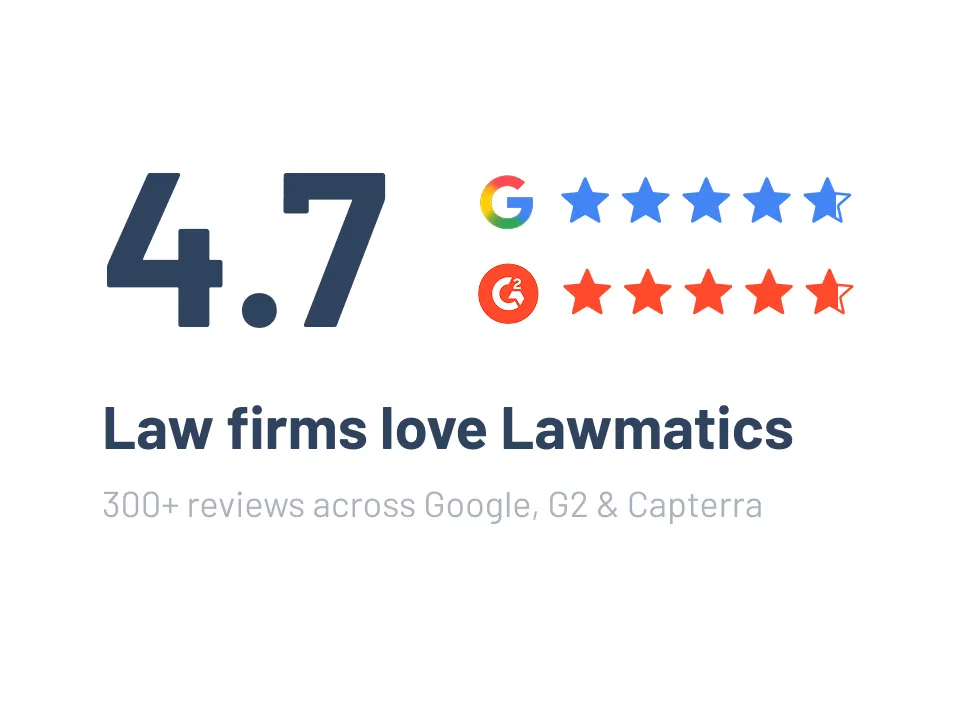




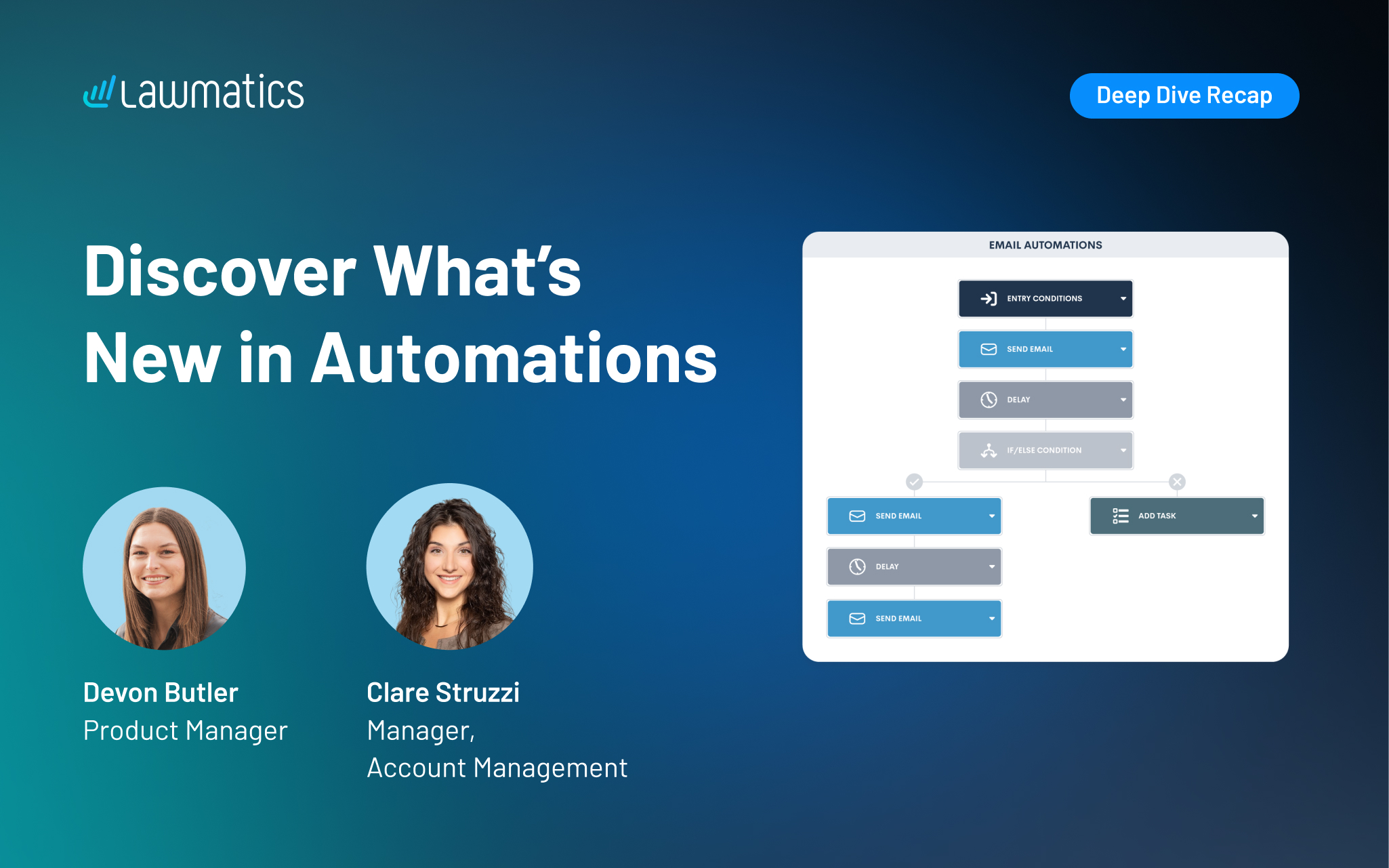







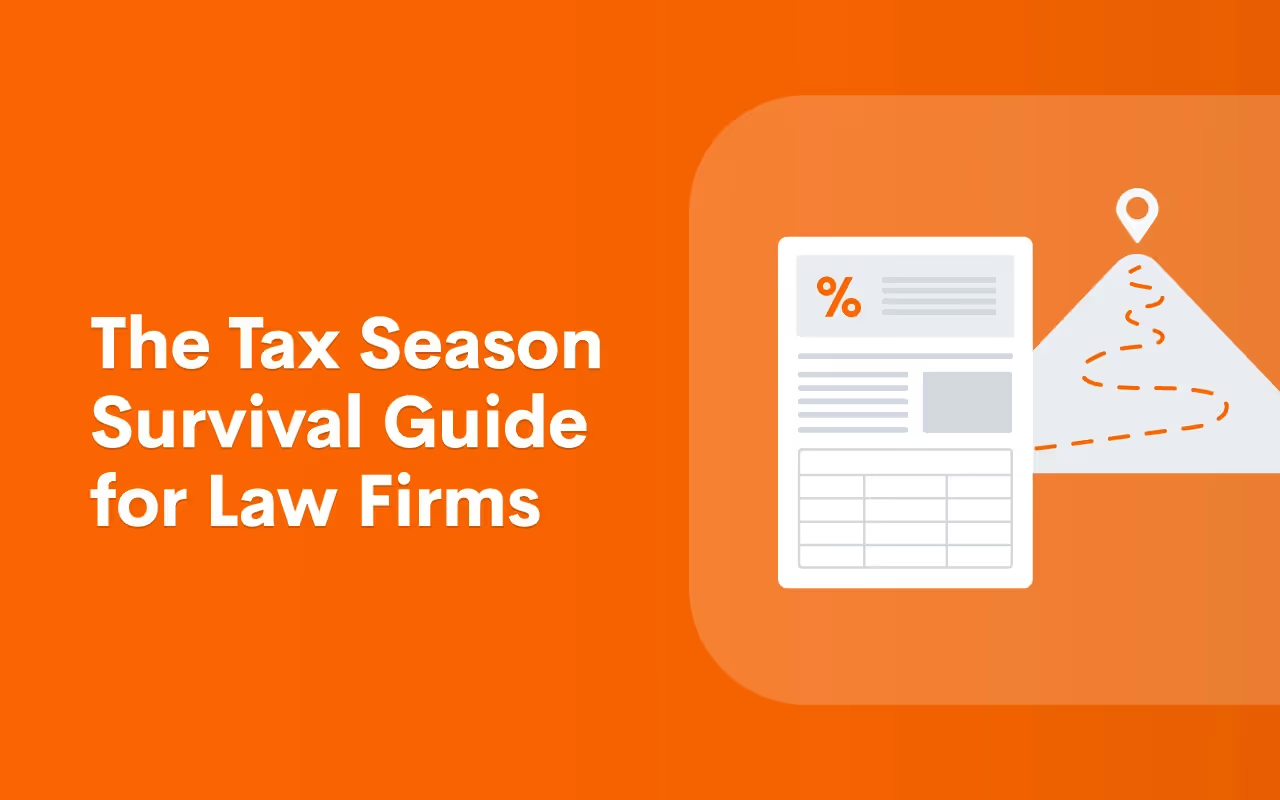
.avif)
.avif)

.avif)
